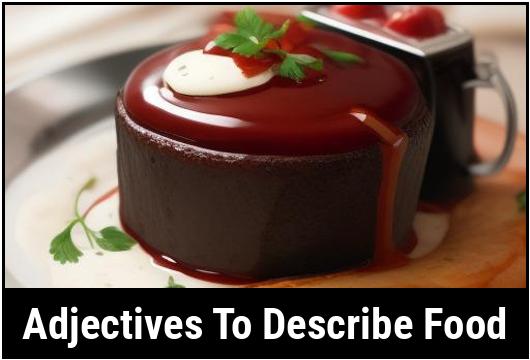- You are here:
- Home »
- adjectives
- » 51 Adjectives To Describe Food

51 Adjectives To Describe Food
When it comes to food, the experience is not simply limited to taste and aroma. The visual appeal, texture, and overall sensory experience play a significant role in how we perceive and appreciate what we eat. Adjectives are powerful tools that can enhance our descriptions of food, elevating our culinary experience to new heights. By using descriptive adjectives, we can effectively convey the flavors, textures, and overall characteristics of food, providing a more vivid and comprehensive picture for the reader or listener.
Key Takeaways
- Adjectives play a crucial role in effectively describing the sensory attributes of food.
- Descriptive adjectives can enhance the culinary experience by providing vivid and detailed accounts of flavor, texture, and appearance.
- Choosing the appropriate adjectives based on the specific characteristics of the food can significantly impact the way it is perceived and appreciated.
Adjectives To Describe Food
1. Scrumptious
When something is scrumptious, it is irresistibly tasty and satisfying. This adjective is often used to describe food that is rich and indulgent, leaving you wanting more.
2. Delectable
Delectable food is delightful and delicious, truly a treat for the taste buds. It’s the type of food that makes you savor every bite, eager for the next.
3. Mouthwatering
Describing food as mouthwatering means it is so appealing and tantalizing that it makes your mouth water in anticipation. Just thinking about it can make you crave a bite.
4. Savory
Savory food is full of flavor, typically salty or spicy. It can be incredibly comforting and satisfying, leaving you feeling warm and content.
5. Flavorful
Describing something as flavorful means it has a distinct and pronounced taste. It refers to food that is well-seasoned, with a perfect balance of flavors that dance on your palate.
6. Aromatic
Food that is aromatic emits a fragrant and pleasant smell. The enticing aroma can make your senses tingle and create an irresistible temptation to indulge.
7. Zesty
Zesty food is bursting with vibrant flavors that awaken your taste buds. It often has a tangy or spicy quality that adds a refreshing and invigorating twist.
8. Creamy
When something is creamy, it is smooth, soft, and rich. This adjective is commonly used to describe foods like sauces and desserts that have a lusciously smooth texture.
9. Crunchy
Crunchy food is characterized by a satisfying crispness or crunch when you take a bite. It adds a textural element that is both satisfying and enjoyable.
10. Fluffy
Describing food as fluffy indicates that it is light, airy, and often has a soft texture. Think of a perfectly risen soufflé or a stack of fluffy pancakes.
11. Succulent
Succulent food is juicy, tender, and full of flavor. It typically describes meats or other ingredients that are moist and delectable.
12. Tangy
Food with a tangy flavor is sharp, acidic, or tart. It adds a zing and liveliness to a dish, often found in ingredients like citrus fruits or vinegar.
13. Refreshing
Refreshing food provides a cool and revitalizing sensation. It is often associated with light and crisp flavors that cleanse your palate.
14. Spicy
Spicy food packs a punch with its heat and intensity. It can add a pleasant burning sensation or a fiery kick that excites and stimulates your taste buds.
15. Exquisite
Describing food as exquisite means it is elegant, refined, and of exceptional quality. It is often reserved for dishes that are meticulously prepared and beautifully presented.
16. Silky
Silky food has a smooth and velvety texture that glides effortlessly in your mouth. It often describes foods like custards or certain types of sauces.
17. Tender
Tender food is soft and delicate, often cooked perfectly to the point where it practically melts in your mouth. It refers to dishes that are enjoyable to chew, without any toughness.
18. Luscious
Food described as luscious is rich, luxurious, and deeply satisfying. The adjective implies indulgence and pleasure, like a decadent chocolate cake.
19. Delightful
Delightful food brings joy and happiness. It is food that makes you smile and fills you with a warm and contented feeling.
20. Satisfying
Satisfying food leaves you feeling content, fulfilled, and pleasantly full. It nourishes both your body and soul, satisfying your hunger and providing a sense of comfort.
21. Crispy
Crispy food has a satisfying crispiness that gives a delightful contrast in texture. It can refer to anything from perfectly golden french fries to crunchy bacon.
22. Flavourful
Flavourful food is full of taste and aroma, with a depth of flavors that entice and satisfy your palate. It often refers to dishes that have been cooked with skill and precision.
23. Velvety
Describing food as velvety means it is luxuriously smooth, like the texture of rich, melted chocolate. It is both comforting and indulgent.
24. Homestyle
Homestyle food refers to dishes that are prepared with traditional recipes and techniques, often evoking a sense of nostalgia and home-cooked comfort.
25. Decadent
Food that is decadent is luxurious, often excessively rich and indulgent. It is the ultimate guilty pleasure that satisfies your cravings for something truly indulgent.
26. Flaky
Flaky food has thin and delicate layers that easily separate. It adds a delightful texture and a satisfying crumble when you take a bite.
27. Tangy
Tangy food has a sharp, zesty, and lively taste that adds a refreshing twist to a dish. It often makes your taste buds tingle with invigorating flavors.
28. Fragrant
Fragrant food emits a delightful aroma that enhances the dining experience. It adds an extra sensory element and increases your anticipation for the flavors to come.
29. Wholesome
Wholesome food is nourishing, nutritious, and promotes overall well-being. It often describes dishes that use fresh and healthy ingredients, benefiting both the body and mind.
30. Melt-in-your-mouth
Describing food as melt-in-your-mouth indicates that it is incredibly tender and soft, dissolving effortlessly as you eat it. It often refers to dishes that have been cooked slowly and meticulously.
31. Heavenly
Heavenly food is divine and blissful, providing a truly extraordinary taste experience. It transports you to a state of culinary ecstasy with every bite.
32. Rich
Rich food is characterized by an abundance of flavors and textures. It often has a satisfyingly heavy and indulgent quality that leaves a lasting impression.
33. Juicy
Juicy food is moist and full of natural juices. It bursts with flavor and can be incredibly refreshing, especially with fruits and succulent meats.
34. Sizzling
Sizzling food is cooked at a high temperature, producing a distinctive sound and enticing aroma. It adds an element of excitement and anticipation to the dining experience.
35. Smoky
Smoky food is infused with the flavors of smoke, often achieved through grilling or smoking techniques. It adds a unique and delightful taste that elevates the overall dish.
36. Velvety
Velvety food has a smooth, luxurious, and creamy texture reminiscent of velvet fabric. It often describes dishes that are rich and satisfying, like a velvety chocolate mousse.
37. Robust
Robust food is hearty and full-bodied, often characterized by strong and well-developed flavors. It leaves a lasting impression and fills you up with its bold taste.
38. Rustic
Rustic food is wholesome and unpretentious, often prepared in a simple and traditional way. It offers an authentic and comforting taste, harkening back to its roots.
39. Crave-worthy
Food that is crave-worthy is so delicious and satisfying that you constantly desire it. It elicits strong cravings and leaves you longing for more.
40. Zingy
Zingy food has a vibrant and invigorating flavor that adds a spark to a dish. It often refers to ingredients that have a tangy or citrusy quality.
41. Irresistible
When something is described as irresistible, it means you simply cannot resist its allure. Irresistible food is so tempting and appealing that you find it impossible to say no.
42. Delicate
Delicate food is subtle, gentle, and often requires careful preparation. It refers to dishes that have elegant and refined flavors, requiring a sensitive palate to truly appreciate.
43. Nourishing
Nourishing food provides vital nutrients and sustenance for your body. It is often associated with meals that are balanced, wholesome, and good for your overall well-being.
44. Melt-in-your-mouth
Describing food as melt-in-your-mouth indicates that it is tender, soft, and dissolves effortlessly with every bite. It is a testament to a dish’s exquisite texture and craftsmanship.
45. Crispy
Crispy food has a pleasing crunchiness that adds a delightful textural contrast. It is often achieved through frying or baking, giving the dish an extra element of satisfaction.
46. Aromatic
Aromatic food emits fragrant and enticing scents that awaken your senses. It adds an extra layer of enjoyment by tantalizing your nose before it even reaches your taste buds.
47. Succulent
Succulent food is moist and juicy, often bursting with delicious flavors. It refers to ingredients that have been cooked to perfection, resulting in tender and delectable dishes.
48. Mouthwatering
Food that is mouthwatering is so appetizing and inviting that it makes your mouth water in anticipation. It elicits a strong desire to taste and savor every morsel.
49. Satisfying
Satisfying food fills you up and leaves you feeling content and nourished. It provides a sense of fulfillment, both physically and emotionally, and satisfies your hunger.
50. Flavourful
Flavourful food is bursting with delicious and distinct tastes. It refers to dishes where careful attention has been paid to the balance and combination of flavors, resulting in a memorable culinary experience.
51. Heavenly
Heavenly food is so remarkably delicious and exquisite that it feels like a taste of paradise. It is the epitome of culinary perfection, providing a transcendent and unforgettable dining experience.
Why Use Adjectives To Describe Food
Describing food using adjectives serves multiple purposes. It not only aids in conveying the sensory attributes of the food but also helps in setting expectations for the consumer or reader. Whether it’s a mouthwatering description on a restaurant menu, a food review, or a recipe blog, adjectives add depth and richness to the portrayal of food. Through vivid descriptions, adjectives can evoke emotions, trigger memories, and entice the senses, making the experience of food more engaging and immersive.
How To Choose The Right Adjective To Describe Food
Selecting the right adjectives to describe food involves considering various factors such as taste, texture, aroma, and appearance. It’s essential to align the adjectives with the specific attributes of the food being described. For example, a delicate, flaky pastry might be better described with adjectives like "buttery" and "crisp," while a hearty stew could be characterized as "hearty," "robust," and "satisfying." Understanding the nuances of different adjectives and their appropriateness in describing various food items is crucial in effectively communicating the culinary experience.
Types Of Adjectives For Describing Food
Taste Descriptors
Savory: Used to describe foods with a rich, umami flavor, often associated with meaty or earthy notes. Example: "The savory aroma of the braised short ribs filled the room."
Bitter: Indicates a sharp, pungent taste often found in dark chocolate, coffee, or certain greens. Example: "The bitter undertones of the espresso complemented the sweetness of the dessert."
Sweet: Describes foods with a sugary or honeyed taste. Example: "The sweet, juicy peaches were a delightful addition to the summer salad."
Sour: Refers to a tart or acidic flavor, often associated with citrus fruits or fermented foods. Example: "The sourness of the lemon curd added a refreshing zing to the dessert."
Texture Descriptors
Crunchy: Characterizes foods with a crisp, firm texture, often achieved through frying or baking. Example: "The crunchy exterior of the fried chicken contrasted with the tender meat inside."
Creamy: Describes foods with a smooth, velvety texture, typically associated with dairy products or purees. Example: "The creamy consistency of the butternut squash soup added a luxurious mouthfeel."
Aroma Descriptors
Fragrant: Indicates a pleasant, aromatic scent, often associated with herbs, spices, and flowers. Example: "The fragrant aroma of freshly baked bread filled the kitchen."
Aromatic: Similar to fragrant, used to describe foods with a strong, distinctive aroma. Example: "The aromatic blend of spices infused the curry with complex flavors."
Appearance Descriptors
Glistening: Describes a glossy, shiny appearance, often associated with foods with a high fat content or glazes. Example: "The glistening glaze on the donuts added an enticing sheen."
Vibrant: Indicates a bright, lively color, often used to describe fresh fruits and vegetables. Example: "The vibrant hues of the mixed berries made the dessert visually appealing."
In the realm of gastronomy, the use of adjectives to describe food serves as a gateway to a richer, more evocative culinary experience. By carefully selecting and utilizing descriptive adjectives that align with the taste, texture, aroma, and appearance of food, we can effectively capture the essence of a dish, tantalize the senses, and create a more immersive and compelling narrative around food. Whether used in culinary writing, menu descriptions, or everyday conversations about food, the art of employing adjectives to describe food is an indispensable tool for enhancing the appreciation and enjoyment of our culinary creations.
Examples Of Adjectives For Different Types Of Food
When it comes to describing food, adjectives play a crucial role in painting a vivid picture of the taste, texture, and overall experience. They help us communicate our culinary preferences, whether it’s savoring a succulent steak, relishing a creamy dessert, or devouring a spicy dish. Adjectives can enhance our food descriptions, making them more engaging and enticing to others.
-
Sweet: This adjective is commonly used to describe foods that have a sugary taste. For example, "The chocolate cake was incredibly sweet, with layers of rich frosting and a moist, tender crumb." Sweet can also be used to describe fruits like strawberries or desserts like ice cream.
-
Savory: Savory describes foods that have a rich and flavorful taste, often associated with umami flavors. An example sentence would be, "The slow-cooked beef stew had a savory aroma and tender meat that melted in my mouth."
-
Spicy: Spicy refers to foods that have a strong and hot taste, usually due to the presence of chili peppers or other spices. For instance, "The curry was incredibly spicy, leaving a warm and tingling sensation on my tongue."
-
Salty: Salty describes foods that have a high sodium content, giving them a distinct saltiness. An example sentence would be, "The popcorn was perfectly salted, with a delicious balance of buttery flavor."
-
Sour: Sour is used to describe foods that have an acidic or tart taste. For example, "The lemonade was refreshingly sour, with a tangy burst of citrus."
-
Bitter: Bitter describes foods that have a sharp and unpleasant taste, often associated with coffee, dark chocolate, or certain vegetables. For instance, "The dark chocolate had a bitter taste, but it was balanced by a hint of sweetness."
-
Rich: Rich is used to describe foods that are abundant in flavor and often have a high fat content. An example sentence would be, "The creamy pasta sauce was rich and indulgent, with layers of melted cheese and velvety texture."
-
Tangy: Tangy describes foods that have a sharp, zesty, or slightly acidic taste. For example, "The salsa had a tangy kick, with a burst of fresh tomatoes, onions, and cilantro."
-
Crispy: Crispy is used to describe foods that are crunchy and firm, often due to being fried or baked. An example sentence would be, "The fried chicken had a crispy golden crust and juicy meat inside."
-
Tender: Tender describes foods that are soft, delicate, and easy to chew. For instance, "The grilled salmon was perfectly cooked, with a tender, flaky texture that melted in my mouth."
-
Juicy: Juicy refers to foods that have a high water content and are full of liquid, often associated with fruits or succulent meats. For example, "The watermelon was juicy and refreshing, with bursts of sweet juice with every bite."
-
Fluffy: Fluffy is used to describe foods that are light, airy, and have a soft texture. An example sentence would be, "The pancakes were fluffy and piled high, with a delicate, melt-in-your-mouth texture."
Common Mistakes In Using Adjectives To Describe Food
While adjectives can greatly enhance our food descriptions, there are some common mistakes to avoid:
-
Overusing generic adjectives: It’s easy to fall into the trap of using generic adjectives like "good," "delicious," or "tasty" when describing food. While these adjectives might suffice in some instances, they lack specificity and fail to evoke a sensory experience. Instead, try to use more descriptive adjectives that provide a clearer picture of the food’s taste, texture, or aroma.
-
Neglecting the senses: When describing food, it’s important to engage all the senses – taste, smell, touch, sight, and even sound. Don’t solely focus on the taste, but also consider the texture, aroma, and visual appeal. For example, instead of saying, "The chocolate cake tasted good," you could say, "The chocolate cake had a rich, velvety texture, a decadent aroma, and a heavenly taste that lingered on my palate."
-
Forgetting to consider cultural context: Different cultures have distinct preferences and standards when it comes to describing food. What might be considered spicy in one culture could be mild in another. When using adjectives to describe food, it’s important to be mindful of the cultural context in which the food is being enjoyed or described.
Using Adjectives Effectively
To use adjectives effectively when describing food, consider the following tips:
-
Be specific: Instead of using vague adjectives, opt for more specific ones that provide a detailed description of the food. For example, instead of saying, "The pizza was good," you could say, "The pizza had a thin, crispy crust, a tangy tomato sauce, and a generous topping of melted cheese."
-
Use sensory language: Engage all the senses by using sensory language in your descriptions. Describe not only the taste but also the aroma, texture, and appearance of the food. This will create a more vivid and immersive experience for the reader or listener. For instance, instead of saying, "The soup tasted good," you could say, "The soup had a fragrant aroma of herbs, a velvety smooth texture, and a delicate balance of flavors."
-
Use comparative and superlative forms: To add more depth to your descriptions, consider using comparative and superlative forms of adjectives. For example, instead of saying, "The steak was tender," you could say, "The steak was exceptionally tender, melting in my mouth with each bite."
-
Be consistent with the overall tone: When describing food, it’s important to maintain a consistent tone throughout your description. If you’re using adjectives to describe a decadent dessert, for example, you wouldn’t suddenly switch to using adjectives associated with health food. Keep your language consistent and appropriate to the type of food you’re describing.
Exercises And Practice
To practice using adjectives to describe food, try the following exercises:
-
Taste testing: Take a variety of foods and carefully taste and analyze their flavors, textures, and aromas. Write down your observations using descriptive adjectives. For example, "The apple had a crisp texture, a slightly tart and refreshing taste, and a sweet aroma."
-
Menu makeover: Take a menu from a restaurant or create your own imaginary menu. Add descriptive adjectives to the menu items to make them sound more enticing and appealing. For example, instead of "Grilled chicken salad," you could write "Succulent grilled chicken salad with crisp, fresh greens, juicy cherry tomatoes, and creamy avocado dressing."
-
Describe a dish: Choose a favorite dish and write a detailed description of it using as many descriptive adjectives as possible. Try to engage all the senses and paint a vivid picture of the food. For example, describe a homemade lasagna as "layers of tender pasta sheets, luscious tomato sauce, savory ground beef, and a generous blanket of melted cheese, baked to perfection and leaving a mouthwatering aroma lingering in the air."
Conclusion
Adjectives are powerful tools when it comes to describing food. They add depth, color, and sensory experience to our descriptions, allowing others to visualize and appreciate the culinary wonders we encounter. By using specific, sensory language and avoiding common mistakes, we can effectively convey the delectable flavors, textures, and aromas of food. So, the next time you have a mouth-watering meal, don’t just say it was good or delicious – dive into the world of adjectives and let your descriptions do justice to the culinary delights that await.
FAQS On Adjectives To Describe Food
What Are Adjectives To Describe Food?
Adjectives are descriptive words that are used to provide more details and descriptions about something. When it comes to describing food, there are a variety of different adjectives that can be used depending on the specific qualities and characteristics of the food.
What Are Some Common Adjectives Used To Describe Food?
Some common adjectives used to describe food are delicious, tasty, flavorful, savory, and mouthwatering. These words are often used to express positive and pleasing qualities of food.
What Do Adjectives Like Spicy, Sweet, And Sour Mean When Describing Food?
Adjectives such as spicy, sweet, and sour are often used to describe the taste and flavor of food. Spicy food has a hot or pungent taste, sweet food is sugary and can be perceived as pleasing to the taste buds, and sour food has a sharp tangy taste.
Can You Use More Than One Adjective To Describe Food?
Yes, it is common to use multiple adjectives to describe food since different adjectives can capture different qualities of the food. For example, you may describe a dish as both creamy and flavorful to highlight its smooth texture and rich taste.
Are There Different Adjectives To Describe Food Texture And Appearance?
Yes, there are different adjectives specifically used to describe the texture and appearance of food. Examples of texture adjectives are crispy, tender, and crunchy, while appearance adjectives include colorful, vibrant, and appetizing. These adjectives can provide a more detailed and sensory description of the food.









